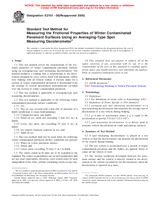Potrebujeme váš súhlas na využitie jednotlivých dát, aby sa vám okrem iného mohli ukazovať informácie týkajúce sa vašich záujmov. Súhlas udelíte kliknutím na tlačidlo „OK“.
ASTM E2101-00(2005)
Standard Test Method for Measuring the Frictional Properties of Winter Contaminated Pavement Surfaces Using an Averaging-Type Spot Measuring Decelerometer (Withdrawn 2014)
Automaticky preložený názov:
Štandardná skúšobná metóda pre meranie vlastností trecích zimné kontaminovaných Pavement povrchov Použitie priemerovanie - Type Spot Meracie decelerometra ( Withdrawn 2014 )
NORMA vydaná dňa 1.6.2005
Informácie o norme:
Označenie normy: ASTM E2101-00(2005)
Poznámka: NEPLATNÁ
Dátum vydania normy: 1.6.2005
Kód tovaru: NS-44293
Počet strán: 4
Približná hmotnosť: 12 g (0.03 libier)
Krajina: Americká technická norma
Kategória: Technické normy ASTM
Anotácia textu normy ASTM E2101-00(2005) :
Keywords:
airport runway friction, braking, deceleration, decelerometer, tire pavement friction, winter conditions, ICS Number Code 13.020.40 (Pollution, pollution control and conservation)
Doplňujúce informácie
| Significance and Use | ||
|
Knowledge of the frictional properties of a winter contaminated pavement surface is essential to evaluate the braking effort of ground vehicles or aircraft operating on a pavement surface. The presence of contaminants on a pavement surface will affect the frictional properties of the surface in a manner which is difficult to evaluate by visual observation alone. The frictional properties of a winter contaminated pavement surface can be characterized using a spot measuring decelerometer which provides a measurement of the surface friction and assists with the evaluation of pavement winter maintenance requirements. The measurements produced by this test method should not be used as the sole criteria to determine pavement winter maintenance requirements. The measurements would normally be combined with visual and other observations to provide a more complete analysis of the pavement surface conditions. A certain amount of discretion is required on the part of the operator as this test method provides only a “spot” measurement of the surface condition. The objective of the operator is to identify areas of the winter contaminated pavement surface which may have lower friction and then obtain friction measurements in those areas. This makes the test method somewhat conservative by nature in comparison to the actual friction potential. The measurements produced by this test method are dependent on the test vehicle parameters and on the braking technique of the vehicle operator. |
||
| 1. Scope | ||
|
1.1 This test method covers the measurement of the frictional properties of winter contaminated pavement surfaces using an averaging-type spot measuring decelerometer. The method produces a reading that is proportional to the deceleration sustained by a test vehicle fitted with pneumatic rubber tires braking with all wheels locked. A friction index for a section of winter contaminated pavement is determined from the average of several deceleration measurements recorded over the section of winter contaminated pavement. 1.2 This test method is applicable to averaging-type spot measuring decelerometers. 1.3 This test method is applicable to the following winter contaminated pavement surface conditions: 1.3.1 Ice; 1.3.2 Wet ice (ice covered with a thin film of moisture of a depth insufficient to cause hydroplaning); 1.3.3 Compacted snow, any depth; 1.3.4 Slush on ice, slush not exceeding 3 mm (0.1 in.) in depth; 1.3.5 Loose, dry snow, not exceeding 25 mm (1 in.) in depth; 1.3.6 Ice control chemical solution on ice; and 1.3.7 Sand on ice. 1.4 This test method shall not be used when the following winter contaminated pavement surface conditions are present: 1.4.1 Water on a bare pavement surface; 1.4.2 Slush; and 1.4.3 Loose snow exceeding 25 mm (1 in.) in depth. 1.5 The values stated in SI units are to be regarded as the standard. The values in parentheses are in inch-pound units and are not exact equivalents, therefore, each system must be used independent of the other, without combining values in any way. 1.6 This standard does not purport to address all of the safety concerns, if any, associated with its use. It is the responsibility of the user of this standard to establish appropriate safety and health practices and determine the applicability of regulatory limitations prior to use. |
||
| 2. Referenced Documents | ||
|
Odporúčame:
Aktualizácia zákonov
Chcete mať istotu o platnosti využívaných predpisov?
Ponúkame Vám riešenie, aby ste mohli používať stále platné (aktuálne) legislatívne predpisy
Chcete vedieť viac informácií ? Pozrite sa na túto stránku.




 Cookies
Cookies
